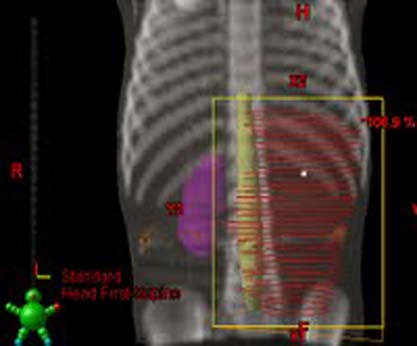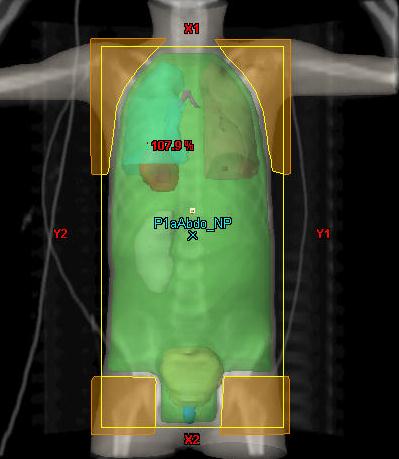Higher Risk Favourable Histology (FH) Wilms Tumor
AREN0533 was the COG research protocol to treat these patients. This study is now closed. The standard of care adopted by most institutions in North America would be to treat high risk Wilms tumor according to this studies' protocol guidelines until another study is available.
There were 2 risk stratifications:
Eligible patients had Stage III and IV FH Wilms Tumor.
1. Patients with pulmonary nodules were given 6 weeks of chemotherapy (vincristine, dactinomycin, and doxorubicin). At the end of that time:
- Patients who had complete disappearance of their lung metastases (or if there is tissue confirmation that nodules do not contain viable tumor) at the Week 6 evaluation were considered rapid responders and continued with chemotherapy alone.
- Patients who did not have complete resolution of pulmonary nodules on CT chest at the week 6 evaluation were given pulmonary RT and switched to a more intense chemotherapy (dactinomycin and doxorubicin given on the same day plus additional cyclophosphamide and etoposide).
This study found patients with favourable histology Wilms tumours with a complete response at week 6 for lung nodules, treated without lung RT had EFS somewhat less than the historical standard treated with lung RT, though this difference was not statistically significant. The excellent overall survival suggests that omission of lung RT may provide an acceptable treatment approach for this patient subgroup.
2. Patients with Stage III and IV FH Wilms tumor with loss of heterozygosity (LOH) of both 1p and 16q were given the more intense chemotherapy (dactinomycin and doxorubicin given on the same day plus additional cyclophosphamide and etoposide).
Indications for RT:
| Primary FH Wilms Tumor |
|
Primary FH Wilms Tumor |
Only patients whose lung metastases are NOT in complete remission after 3-drug chemotherapy on CT scan at Week 6 given whole lung RT.
(Initial tumor size, number of lesions and |
Site |
Indications & RT Dose |
Flank RT |
Stage III:
Stage III local tumor spillage:
(Flank or peritoneal biopsy, open biopsy, flank surgical spillage during surgery) |
Whole Abdomen RT |
Stage III with
Diffuse unresectable peritoneal implants:
|
Whole Lung RT |
Lung metastases:
NB In AREN0533 patients who had complete disappearance of their lung metastases (or if there was tissue confirmation that nodules did not contain viable tumor) at the Week 6 evaluation were considered rapid responders and continued with chemotherapy alone. This did not lead to an increased risk of pulmonary relapse and spared these children pulmonary RT.
|
Lymph Node Irradiation |
Lymph node metastasis not surgically removed:
|
Liver Irradiation |
Liver metastases
|
Flank RT
Volumes:
| Radiation Volume | Definition |
Gross Tumor Volume GTV |
|
Clinical Target Volume CTV |
|
Planning Target Volume PTV |
|
- The medial border of RT field extends across midline to include entire width of vertebral bodies (with a margin of 1 cm) at level concerned, but not so as to overlap any part of the contralateral kidney.
- RT field should not extend to the dome of the diaphragm unless tumor extends to that height.
- If positive lymph nodes have been surgically removed, then the entire length of the para-aortic chain of lymph nodes should be included in RT field
- An antero-posterior parallel-opposed technique (AP-PA) is recommended for flank irradiation.
The image below shows a typical flank field:

Coned down boost RT
- Conformal coned down boost RT used for patients with gross residual tumor after surgery (primary or recurrent Wilms tumor).
- 3D conformal RT can be used, post-chemotherapy and post-operative CT &/ MR imaging data acquired with patient in the treatment position and then GTV , CTY and PTV can be outlined.
- The boost dose is 10.8 Gy is to gross residual tumor after surgery.
GTV = post-chemotherapy and post-operative gross residual tumor
CTV = clinical target volume = anatomically defined margin of 1.0 cm surrounding the GTV. The CTV can be extended to include the entire width of the vertebral body.
PTV = planning target volume = CTV + institution specific geometric margin of usually (0.5-1.0 cm) to account for variation is daily treatment.
- The dose to more than 1/3 (a third) of the contralateral kidney, or to the residual normal kidney for patients with bilateral Wilms tumor, should not exceed 1440 cGy
- The dose to more than 1/2 (one half) the uninvolved liver should not be more than 1980 cGy.
Whole Abdomen RT
The clinical target volume (CTV) is the entire peritoneal cavity:
- Extending from the dome of the diaphragm superiorly to the pelvic diaphragm inferiorly, and laterally from the right to the left lateral abdominal wall.
- Femoral heads should be shielded during whole abdominal RT.
- An antero-posterior parallel-opposed technique (AP-PA) is used.
- When the total dose delivered is 21 Gy (for diffuse peritoneal implants), renal shielding should be used to limit the dose to the remaining kidney so that is does not receive more than 14.4 Gy.
Extent of fields for Whole Abdominal RT:
Superior limit |
1 cm above the dome of the diaphragm |
Inferior limit |
The bottom of the obturator foramen |
Lateral border |
1 cm beyond the lateral abdominal wall |
Whole lung RT
- Both lungs are given RT regardless of the number and location of the metastases.
- CTV includes the entire lungs, mediastinum and the pleural recesses.
- The superior, inferior and lateral borders of the radiation therapy fields are placed 1 cm beyond the CTV.
- If a patient needs both whole lung and infradiaphragmatic RT, then both fields should be treated at the same time.
- The shoulder joints should be protected by MLC shielding.
- Infants less than 12 months old have the whole lung dose reduced to 10.5 Gy in 150 cGy fractions.
- Localized lung metastases persisting two weeks after the delivery of whole lung RT may either be excised or given an additional 750 cGy in 5 fractions.
- The volume of the lungs included in this boost RT field
should be less than 30% in order to limit the risk of acute and long-term pneumonitis.
- The volume of the lungs included in this boost RT field
Extent of fields for Lung RT:
Superior limit |
Above the apices of both lungs |
Inferior limit |
The inferior extent of the anterior and posterior costo-diaphragmatic recesses of the pleural cavity should be included (assess carefully with CT). Approximately at the L-1 vertebral body level |
Lateral border |
1 cm beyond the thoracic wall. |
See below for image of whole lung and whole abdominal RT (green volume). The patient received 1050 Gy in 150 cGy fractions to this entire volume and then the field size was reduced so that the abdomen was no longer treated (diaphragmatic recesses were carefully identified so both lungs remained entirely within the treatment volume). One more fraction was given to bring the total lung dose to 12 Gy in 150 cGy fractions.

Pre-operative Chemotherapy
This is standard of care in Europe.
In North America, initial nephrectomy is followed by adjuvant chemotherapy.
However, in North America pre-operative chemotherapy is increasingly used and recommended in certain specific circumstances.
Basis for pre-operative chemotherapy in North America:
Required conditions |
Massive unresectable unilateral disease
Bilateral Wilms tumor
Wilms tumor in solitary kidney
Tumor thrombus in inferior vena cava |
Goals |
Reduce tumor bulk
Render disease operable
Decrease frequency of tumor rupture at the time of nephrectomy |
Disadvantages |
Loss of correct staging information since histologic classification reflects chemotherapy-induced changes
Mistreatment for benign lesions or conditions that are not Wilms tumor can occur
False down-staging due to obscure perinephric tumor extensions (changes in histologic pattern, and alteration of eventual stage due to resolution of intra-abdominal metastases) |

